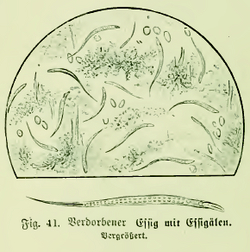Biology:Turbatrix aceti
| Vinegar eels | |
|---|---|

| |
| Illustration of vinegar eels | |
| Scientific classification | |
| Domain: | Eukaryota |
| Kingdom: | Animalia |
| Phylum: | Nematoda |
| Class: | Secernentea |
| Order: | Tylenchida |
| Family: | Panagrolaimidae |
| Genus: | Turbatrix |
| Species: | T. aceti
|
| Binomial name | |
| Turbatrix aceti (Müller, 1783)
| |
| Synonyms | |
| |
Turbatrix aceti (vinegar eels, vinegar nematode, Anguillula aceti) are free-living nematodes that feed on a microbial culture called mother of vinegar (used to create vinegar) and may be found in unfiltered vinegar. They were discovered by Pierre Borel in 1656.[1]
Their environment makes them exceptionally tolerant of variation in acidity and alkalinity and they may be able to tolerate a wider range than any other species, being able to survive from pH 1.6 to 11.[2]
Vinegar eels are often given to fry (baby fish) as a live food, like microworms.[1][3] Although they are harmless and non-parasitic, leaving eels in vinegar is considered objectionable in the United States for example and is not permitted in vinegar destined for American consumers.[4] Manufacturers normally filter and pasteurize their product prior to bottling, destroying the live bacterial and yeast culture that these nematodes require for sustenance.
At high concentration near a boundary, vinegar eels synchronize their undulations, forming a collective wave.[5][6]
Aging in T. aceti is associated with a decline in the ability to repair DNA damage,[7][8] a finding that is consistent with the theory that DNA damage contributes to aging.[9]
References
- ↑ 1.0 1.1 "The Chesapeake Area Killifish Club: Vinegar Eels". http://www.chesapeakekillifish.org/page.php?26.
- ↑ Schulze-Makuch, Dirk; Irwin, Louis Neal (2008-10-02) (in en). Life in the Universe: Expectations and Constraints. Springer Science & Business Media. pp. 57. ISBN 9783540768166. https://books.google.com/books?id=qdjoTGAvrkkC&pg=PA57.
- ↑ "Vinegar Eels". 2012-02-22. http://rainbowfish.angfaqld.org.au/vinegar.htm.
- ↑ "FDA: Sec. 525.825 Vinegar, Definitions - Adulteration with Vinegar Eels (CPG 7109.22)". https://www.fda.gov/ICECI/ComplianceManuals/CompliancePolicyGuidanceManual/ucm074471.htm.
- ↑ Peshkov, Anton; McGaffigan, Sonia; Quillen, Alice C. (2022). "Synchronized oscillations in swarms of nematode Turbatrix aceti". Soft Matter 18 (6): 1174–1182. doi:10.1039/D1SM01572A. PMID 35029257. Bibcode: 2022SMat...18.1174P. https://pubs.rsc.org/en/content/articlehtml/2022/sm/d1sm01572a.
- ↑ Quillen, A. C.; Peshkov, A.; Wright, E.; McGaffigan, S. (2021). "Metachronal waves in concentrations of swimming Turbatrix aceti nematodes and an oscillator chain model for their coordinated motions". Physical Review E 104 (1): 014412. doi:10.1103/PhysRevE.104.014412. PMID 34412226. Bibcode: 2021PhRvE.104a4412Q. https://journals.aps.org/pre/abstract/10.1103/PhysRevE.104.014412.
- ↑ Targovnik HS, Locher SE, Hart TF, Hariharan PV. Age-related changes in the excision repair capacity of Turbatrix aceti. Mech Ageing Dev. 1984 Sep;27(1):73-81. doi: 10.1016/0047-6374(84)90083-6. PMID 6492888
- ↑ Targovnik HS, Locher SE, Hariharan PV. Age associated alteration in DNA damage and repair capacity in Turbatrix aceti exposed to ionizing radiation. Int J Radiat Biol Relat Stud Phys Chem Med. 1985 Mar;47(3):255-60. doi: 10.1080/09553008514550381. PMID 3872278
- ↑ Gensler HL, Bernstein H. DNA damage as the primary cause of aging. Q Rev Biol. 1981 Sep;56(3):279-303. doi: 10.1086/412317. PMID 7031747
Wikidata ☰ Q1368890 entry
 |

